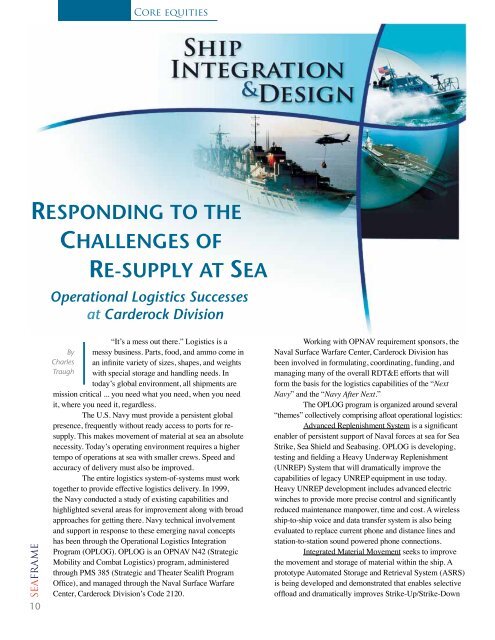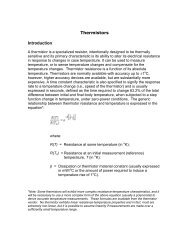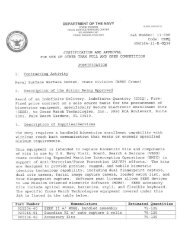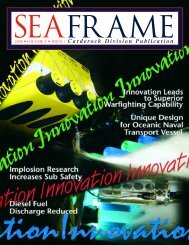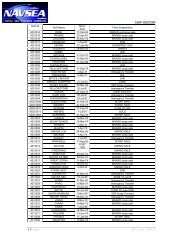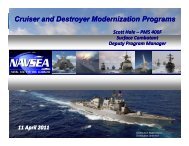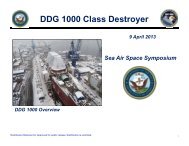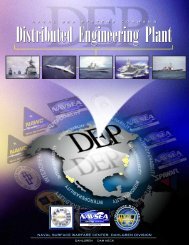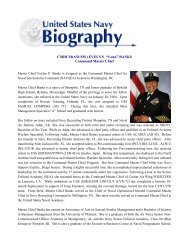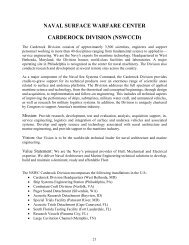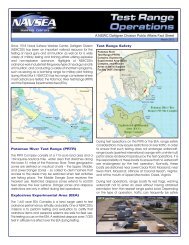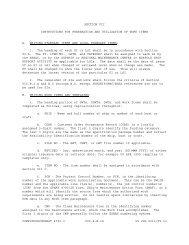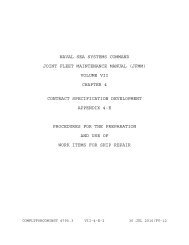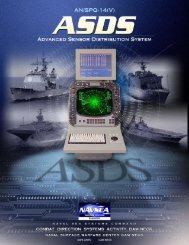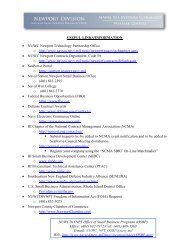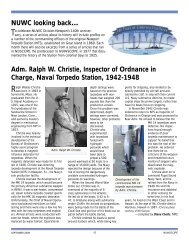Volume 6, Issue 1 - Naval Sea Systems Command - The US Navy
Volume 6, Issue 1 - Naval Sea Systems Command - The US Navy
Volume 6, Issue 1 - Naval Sea Systems Command - The US Navy
Create successful ePaper yourself
Turn your PDF publications into a flip-book with our unique Google optimized e-Paper software.
SEAFRAME<br />
10<br />
Core equities<br />
RESPONDING TO THE<br />
CHALLENGES OF<br />
By<br />
Charles<br />
Traugh<br />
RE-SUPPLY AT SEA<br />
Operational Logistics Successes<br />
at Carderock Division<br />
“It’s a mess out there.” Logistics is a<br />
messy business. Parts, food, and ammo come in<br />
an infinite variety of sizes, shapes, and weights<br />
with special storage and handling needs. In<br />
today’s global environment, all shipments are<br />
mission critical ... you need what you need, when you need<br />
it, where you need it, regardless.<br />
<strong>The</strong> U.S. <strong>Navy</strong> must provide a persistent global<br />
presence, frequently without ready access to ports for resupply.<br />
This makes movement of material at sea an absolute<br />
necessity. Today’s operating environment requires a higher<br />
tempo of operations at sea with smaller crews. Speed and<br />
accuracy of delivery must also be improved.<br />
<strong>The</strong> entire logistics system-of-systems must work<br />
together to provide effective logistics delivery. In 1999,<br />
the <strong>Navy</strong> conducted a study of existing capabilities and<br />
highlighted several areas for improvement along with broad<br />
approaches for getting there. <strong>Navy</strong> technical involvement<br />
and support in response to these emerging naval concepts<br />
has been through the Operational Logistics Integration<br />
Program (OPLOG). OPLOG is an OPNAV N42 (Strategic<br />
Mobility and Combat Logistics) program, administered<br />
through PMS 385 (Strategic and <strong>The</strong>ater <strong>Sea</strong>lift Program<br />
Office), and managed through the <strong>Naval</strong> Surface Warfare<br />
Center, Carderock Division’s Code 2120.<br />
Working with OPNAV requirement sponsors, the<br />
<strong>Naval</strong> Surface Warfare Center, Carderock Division has<br />
been involved in formulating, coordinating, funding, and<br />
managing many of the overall RDT&E efforts that will<br />
form the basis for the logistics capabilities of the “Next<br />
<strong>Navy</strong>” and the “<strong>Navy</strong> After Next.”<br />
<strong>The</strong> OPLOG program is organized around several<br />
“themes” collectively comprising afloat operational logistics:<br />
Advanced Replenishment System is a significant<br />
enabler of persistent support of <strong>Naval</strong> forces at sea for <strong>Sea</strong><br />
Strike, <strong>Sea</strong> Shield and <strong>Sea</strong>basing. OPLOG is developing,<br />
testing and fielding a Heavy Underway Replenishment<br />
(UNREP) System that will dramatically improve the<br />
capabilities of legacy UNREP equipment in use today.<br />
Heavy UNREP development includes advanced electric<br />
winches to provide more precise control and significantly<br />
reduced maintenance manpower, time and cost. A wireless<br />
ship-to-ship voice and data transfer system is also being<br />
evaluated to replace current phone and distance lines and<br />
station-to-station sound powered phone connections.<br />
Integrated Material Movement seeks to improve<br />
the movement and storage of material within the ship. A<br />
prototype Automated Storage and Retrieval System (ASRS)<br />
is being developed and demonstrated that enables selective<br />
offload and dramatically improves Strike-Up/Strike-Down


